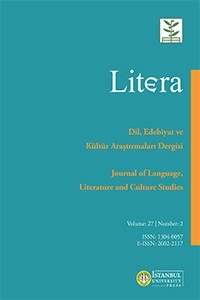Representation of History in Literature: The Language of Barcelona as a Novel City
This study aims to analyse two of the most influential novels of 20th century Spanish literature, The city of marvels by Eduardo Mendoza and Nada by Carmen Laforet in order to reveal the strong contrast between these two Barcelonas, the background of which, are as follows - the Barcelona of the transition period between the 19th and 20th centuries and the post-Civil War Barcelona of the 20th century. Both novels use Barcelona as a setting for their stories and these two Barcelonas are completely different from each other in terms of both progress in and suspension of social and city lives. The city of marvels tells the outstanding rise of Barcelona in social industrial and economic levels during the period between the end of the 19th century and the beginning of the 20th century. The tale of the city is told between Barcelona’s World Fairs of 1888 and 1929; during this time the city presents a significant development with respect to social growth, modernization and well-being. In the age of great inventions, the language of the city reflects trasformation, progress and hope. Carmen Laforet’s Nada tells of a post-Civil War Barcelona. The story begins in 1939, at the end of the Spanish Civil War, and ends almost a year later. The city presents a sad and miserable image as a result of the prevailing atmosphere of grief and disconsolation. The language of the city is constructed at times by a profound silence and at others a verbal violence, as a natural consequence of the tension that reigns
Keywords:
Eduardo Mendoza, The city of marvels, Carmen Laforet, Nada Barcelona,
___
- Cerezales, A. (1995, enero 13). Nada. ABC literario, p. 22.
- Crespo Matellán, S. (1988). Aproximación al concepto de personaje novelesco: los personajes en Nada de Carmen Laforet. Anuario de Estudios Filológicos, 11, 131–148.
- Delibes, M. (1990). Pegar la hebra. Barcelona, España: Ediciones Destino.
- Garbisu Buesa, M. (2000). El juego realidad - ficción en La ciudad de los prodigios de Eduardo Mendoza. Espéculo: Revista de Estudios Literarios, (16), 16–16.
- Giménez Mico, M.J. (2000). Eduardo Mendoza y las novelas españolas de la transición. Madrid, España: Editorial Pliegos.
- Hoeg, J. (2007). La ciudad de los prodigios de Eduardo Mendoza frente a una visión latinoamericana de ciencia, cultura y tecnología. Revista Iberoamericana, 73(221), 861–870.
- Kronik, J.W. (1981). Nada y el texto asfixiado: proyección de una estética. Revista Iberoamericana, 47(116-117), 195–202.
- Laforet, C. (2018). Nada (16a Ed.). Barcelona, España: Editorial Planeta.
- Martín Gaite, C. (1993). Desde la ventana: Enfoque femenino de la literatura española. Madrid, España: EspasaCalpe.
- Mendoza, E. (2018). La ciudad de los prodigios (6a Ed.). Barcelona, España:Editorial Planeta.
- Valles Calatrava, J. R. (2017). Papeles y facetas de los personajes en La ciudad de los prodigios de Eduardo Mendoza. Revista Hispánica de Cultura y Literatura, 32(2), 192–203.
- Başlangıç: 1954
- Yayıncı: İstanbul Üniversitesi
